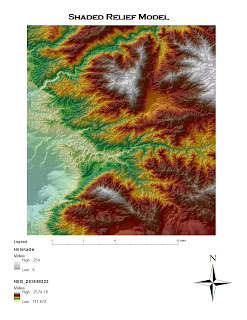The Total Black Alone Population
shows distinct trends in dispersion of black individuals across the United
States. Central and Southern California support a large number of African
Americans, but the population count is quickly cut off outside the state’s
borders. Most of the mid-west and northern United States are populated by very
few African Americans. The south, south-east and north-east are home to the
majority of American Americans in the United States. This map is interesting
and useful because of its obvious representation made possible by GIS’s
attention to detail. When fewer subdivisions of population measures were used,
the trend was not clearly defined. Thanks to the customization available on the
program, I was able to make a coherent map that provides useful information.
The Total Asian Alone Percentage
map shows the percentage of Asians in a county in comparison to the total
county population. One can see that Asians are clustered on the coastal cities
such as Los Angeles, New York and Miami. It seems as though they have then
spread throughout the rest of the states from those three main points. One
could use this map to further investigate immigration trends of Asians
throughout history. It would be useful to compare this map to the Total Asian
Alone Population map to see if the percentages are accurate representations of
Asian migration or just a reflection of limited or excessive county
population.
I have interpreted this map to
express the diversity of individuals within a county in regards to those other
than white, black and Asian decent. The percentage creates a gradient from west
to east, with the highest percentage of “some other race” in the former and the
lowest percentage in the latter. It would be useful to pair this map with an
immigration levels map or a population density map in order to better grasp why
the percentage breakdown is as such. GIS was again helpful in creating this
graphic by providing enough customizability so this trend could accurately be
displayed. When fewer levels of percentage breakdowns were chosen this distinct
pattern was not visible.
CONCLUSION
This series of maps were helpful
because they raised a series of questions that may have been ignored if this
information was not available. GIS’s
customizability and attention to detail were huge factors in being able to
generate these images. With further effort I would be able to pair these graphs
with other ones, add more information, titles and scenarios and eventually
provide the answers to the questions. For example, I could create an Asian
immigration rate map that goes along with the Total Asian Alone Percentage map
to describe why they have mainly congregated along three coastal cities.
This was the first lab in which I felt
as if I was left alone with the steps and procedures to customize the map. At
first I was skeptical, but GIS proved to be a very rational and easy-to-use
program. Everything I wished to do was easily accessible and things played out
smoothly.









